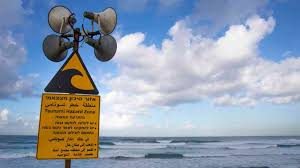Tsunamis are among the most powerful and destructive natural disasters on Earth. Triggered by underwater earthquakes, volcanic eruptions, or landslides, they generate massive waves capable of traveling at speeds up to 800 km/h across the ocean.
These waves can reach heights of 30 meters and stretch up to 100 kilometers wide, devastating everything in their path. While often associated with the Pacific region, tsunamis pose a global threat. The 2004 Indian Ocean tsunami claimed over 230,000 lives, and the 2011 tsunami in Japan resulted in 20,000 deaths.
Europe, too, has faced tragedy—from the 1755 Lisbon tsunami to the Aegean Sea event in 2020. These disasters highlight the urgent need for effective tsunami warning systems and preparedness worldwide.
Read More: Understanding Tsunamis and the Importance of Warning Systems
How Tsunami Warning Systems Work
Given the speed and destructive force of tsunamis, many nations have implemented sophisticated warning systems to safeguard coastal populations. These systems aim to deliver timely, accurate alerts that allow emergency services to evacuate at-risk areas and minimize loss of life.
The most tsunami-prone region is the Pacific’s “Ring of Fire,” where tectonic plates collide, causing frequent earthquakes and volcanic activity. Countries like Japan and Indonesia, located in this zone, have developed highly effective early warning infrastructures.
Modern tsunami warning systems consist of two primary components: detection and alert dissemination. Seismic monitoring stations, often paired with GPS-enabled buoys, track underwater disturbances. Data is transmitted via satellite to centralized centers that assess tsunami risk.

The speed of response varies; in Japan’s 2011 disaster, warnings were issued within just three minutes—an impressive feat that has since been further refined through ongoing technological advancements.
Similar systems are operational in nations such as Australia, Chile, India, and the United States, particularly in tsunami-vulnerable regions like Hawaii and Alaska.
Sirens, Applications, and Control Centres: The Backbone of Tsunami Warnings
When a tsunami threat is detected, immediate evacuation to higher ground or inland areas is critical. To ensure rapid and effective communication, modern tsunami warning systems employ a multi-channel approach that combines technology and coordination.
These systems are designed to reach as many people as possible, including vulnerable and remote communities.Alerts are typically delivered via radio, internet platforms, and mobile text messages.
While fast and convenient, these methods may not reach everyone, particularly in cases of power outages or network disruptions. Therefore, they are supported by centralized control centres, which are directly integrated with sensor networks.
These hubs oversee the warning distribution and activate further emergency measures, including sirens.Acoustic sirens, either automatically or manually triggered, are among the most reliable components.
Backed by redundant power supplies and linked to sensor data, they can transmit tones or voice messages to guide evacuations and coordinate emergency responses in real time.
Telegrafia, a company with proven expertise in tsunami warning solutions in regions like Malaysia and the French Pacific, offers comprehensive systems. Their flagship Pavian electronic sirens and Vektra® software provide first responders with robust, scalable tools adaptable to various emergencies beyond tsunamis.
In disasters where every second counts, the ability to scale and combine warning technologies ensures broader protection and faster responses—making these systems indispensable across tsunami-prone regions.
Frequently Asked Questions (FAQs)
What causes a tsunami?
Tsunamis are typically caused by underwater earthquakes, volcanic eruptions, or submarine landslides. These sudden movements displace large volumes of water, generating powerful waves that can travel across entire ocean basins.
How do tsunami warning systems work?
Modern systems rely on a network of seismic sensors, GPS buoys, and ocean pressure gauges to detect underwater disturbances. This data is analyzed in real-time and, if a tsunami threat is confirmed, alerts are issued via control centers, mobile apps, sirens, and broadcast systems.
How much time do people have to evacuate after a warning?
Evacuation time can range from a few minutes to several hours, depending on the tsunami’s origin and proximity to the coastline. In Japan’s 2011 tsunami, warnings were issued within 3 minutes—highlighting the importance of rapid-response systems.
Are tsunami warnings always accurate?
While no system is flawless, advancements in technology have significantly improved forecast accuracy and response times. Systems now use real-time data and modeling to reduce false alarms and deliver timely alerts.
What should I do if I hear a tsunami warning?
Immediately move inland and to higher ground. Avoid the coast, rivers, and low-lying areas. Follow official instructions via radio, emergency apps, or sirens. Never wait to see the wave before evacuating.
Can sirens and apps be used for other emergencies?
Yes. Systems like Telegrafia’s Pavian sirens and Vektra® software are scalable and multi-purpose, making them effective for earthquakes, floods, industrial accidents, and civil defense alerts.
Conclusion
Tsunamis are among the most devastating natural disasters, capable of causing immense destruction within minutes. Their unpredictable nature and rapid onset make early detection and warning systems not just important—but essential. By combining seismic sensors, satellite communication, acoustic sirens, and real-time control centres, modern tsunami warning systems provide critical time for evacuation and emergency response.

